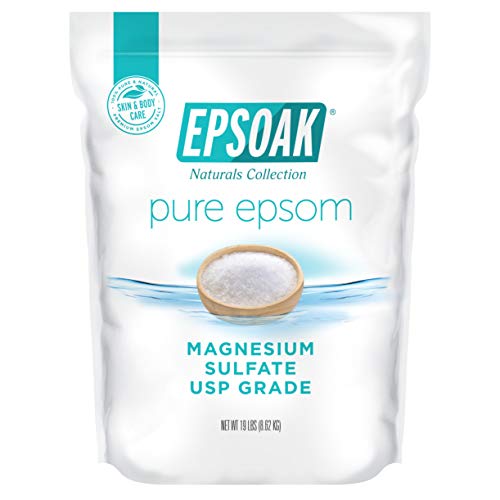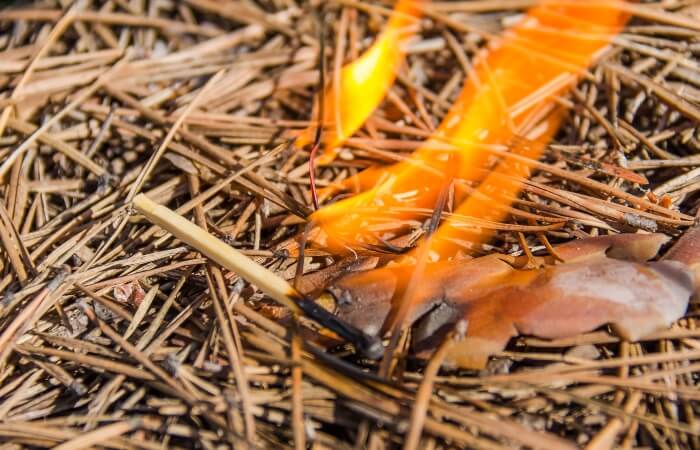Tree stumps are a common landscaping dilemma that is costly to remove.
Luckily, homeowners have a trick on killing a tree stump that is both affordable and effective, and I tell you about it right here.

Learn what kills tree stumps, and the details of the Epsom Salt method, including the pros and cons, steps to kill a stump, and how long it takes.
Once you try this “home-remedy” for how to kill a tree stump, you can prevent bothersome regrowth and achieve a more attractive home and garden!
What Kills Tree Stumps?
Here are the top five ways people kill off a growing tree stump:
- Covering the stump with thick black plastic or cloth
- Burning the stump
- Applying a strong herbicide
- Grinding out the stump
- Applying rock salt or Epsom salt (magnesium sulfate)
- Copper nails to kill a tree
While these methods are effective, some take a long time to work, some are bad for the environment, and some are costly.
That’s why many homeowners prefer using a natural and low-cost DIY tree stump killing method like Epsom salts before moving on to more invasive treatments.
Pros And Cons Of Using Epsom Salt
To determine if Epsom salts are best to kill your tree stump, take a moment to consider all these pros and cons:
Pros:
- Inexpensive
- Readily available
- Easy to apply
- Can do it on your own time schedule
- Doesn’t require hard physical labor
- Adds helpful sulfur and magnesium to nearby soil
Cons:
- Can take a long time to see results
- Need to use large doses of salt
- Must reapply every few weeks
- Salt draws moisture from surrounding soil
How To Remove A Tree Stump With Epsom Salt
There are two ways to use Epsom salts to kill a tree stump: drilling or soaking. Follow these simple steps for either method to kill tree stump regrowth and help the wood rot out for easy removal:
Drilling Method
Step 1 – Start Fast
The sooner you apply Epsom salts (or any topical killing treatment) to a freshly-cut tree stump, the better. The natural capillary action of the trunk and root systems are still working on a newly cut tree and will slow down as time passes. The faster you can get the salts into the roots, the quicker the tree stump will die.
Step 2 – Uncover Roots (Optional)
To encourage faster death of the tree stump, use a hoe to uncover as many large roots near the stump so that you can treat them.
Step 3 – Drill Holes
To quicken the pace of stump death and decomposition, you need to drill holes in the stump. For best results, use a drill bit 8-12 inches long and one inch in diameter.
Following a circular pattern around the stump surface, drill holes down into the stump as far as you can. Space the holes about three inches apart from each other until you cover the top of the stump.
If possible, drill shorter holes into any roots you uncovered without cutting completely through the root.
Step 4 – Fill Holes
Fill the holes with 100-percent Epsom salt and slowly add water so the salt is moist. The water helps draw the salt into the tree’s cells, which will begin drying them out.
Step 5 – Cover Roots
If you uncovered roots, pour a thick layer of Epsom salt over the entire surface and any drill holes.
Step 6 – Reapply Salt
Check on the stump every couple of weeks (or after heavy rainfall) and reapply salt as necessary to keep the holes full and roots covered. If you spot any new growth, this means the salts haven’t dried up enough cells yet.
Once the stump dies off, the decomposition process will break down the wood. You can quicken this process by adding a high-nitrogen fertilizer such as cow manure, which helps feed beneficial microbes and bacteria.
Soaking Method
Step 1 – Create Salt Solution
For one stump, mix one gallon of Epsom salt with two gallons of water. Stir the ingredients until the salt dissolves. Warmer water helps the salt integrate faster.
Step 2 – Apply Solution
Slowly pour the salt mixture over the top of the stump and any roots until it saturates into the wood. Pour any remaining solution over the top of the stump.
Step 3 – Cover Stump
Take a tarp or thick plastic sheeting and secure it over the stump to prevent rain or sunlight from affecting the salt solution’s action.
Step 4 – Reapply Solution
Every week, uncover the stump, pour a new batch of liquid and cover again. Repeat this process until the stump looks very dried out and no regrowth is visible.
How Long Does Epsom Salt Take To Kill A Stump?
Expect a large tree stump to die off from Epsom salt application in four to eight weeks. Smaller stumps may require less time if you reapply the salt often.
The length of time it takes to kill a stump with this method may not work for those in a hurry to landscape their yard to perfection. For those gardeners who aren’t in a rush, this method does work and doesn’t require much time commitment.
How do you know the tree stump is dead? Dead wood will appear dark and lifeless. As it starts to decompose, the bark will flake off, and the stump surface may appear jagged around the holes.
I like this method of stump removal because, with patience, you can watch the stump break down and turn from an eyesore into a compost or mulch-like additive that enriches your garden.
In Summary
There are times when killing a tree stump needs to be done quickly, and paying for a stump grinding or removal service is worth the cost.
Other times you may feel compelled to turn to stump burning or using synthetic chemicals to kill and remove a tree stump, even if it’s harmful to the soil or air.
Now you know that you can achieve the same final result with a much lower cost, minimal effort, and less damage to the environment by using Epsom salts to kill a tree stump, so give it a try!











